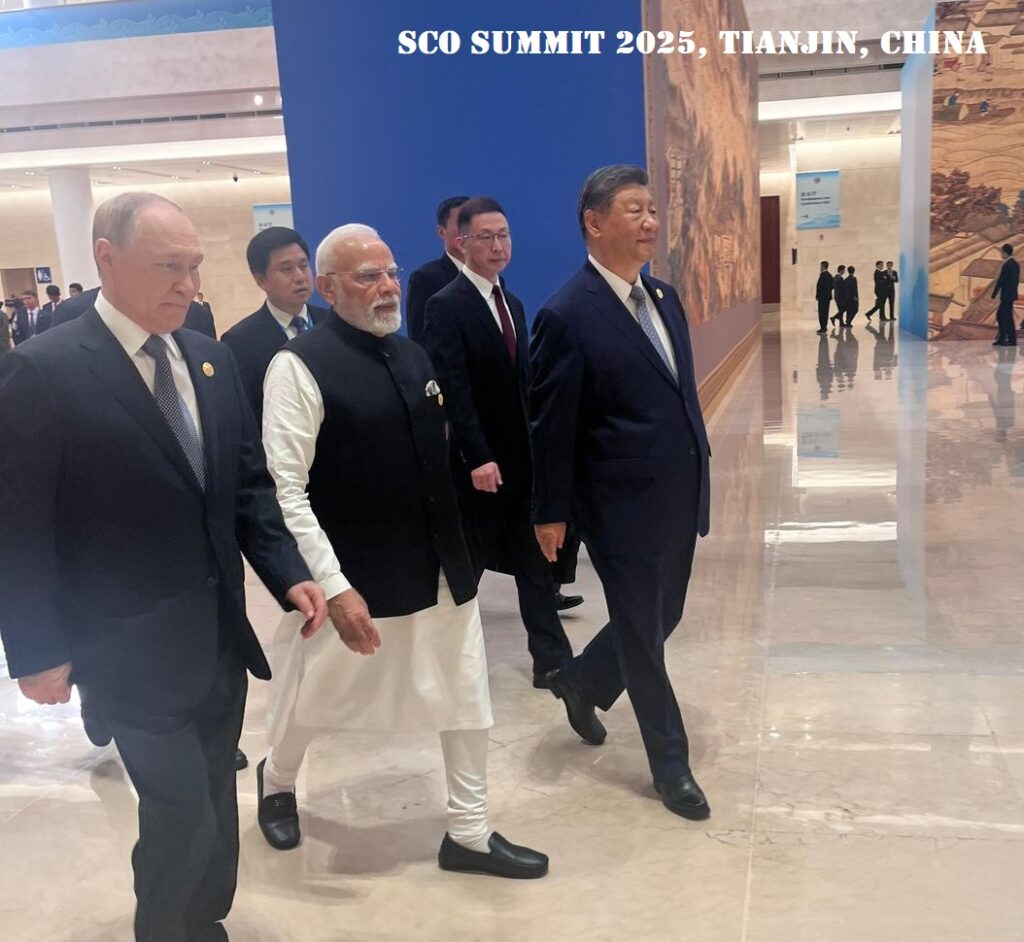
- Geopolitics is about shades of grey, where a nation’s strategic autonomy is not the absence of relationships but the capability to enter and exit relationships on its terms.
- PM Modi’s statement that peace and stability have been created on the border is important as a political fact; it reduces the immediate risk of kinetic escalation and expands the political space for economic cooperation.
- Prime Minister’s visit to Tianjin will not go down as placating China but as a tactical readjustment in an environment characterised by geopolitical flux.
- Engagement with China does not erase Galwan, nor does Trump’s tariff erase India-US ties.
The anarchic international system in 2025 feels like it’s sitting on a geopolitical fissure, where established relations are heading against new realities, much like Earth’s tectonic plates covertly shifting under us until the inevitable quake hits. PM Narendra Modi’s visit to Tianjin for the 25th edition of the SCO summit, and notably his meeting with Chinese President Xi Jinping on the sidelines, can be read as an interesting moment coupled with both symbolism and tactical importance. Unlike his last meeting with President Xi at Kazan, this visit came at a time when India is refining its options amid Washington’s irrational imposition of a 50% tariff on Indian goods.
Modi’s SCO Tour: Symbolism Beyond Optics
On the surface level, Modi’s meeting with Xi at Tianjin may come out as a diplomatic courtesy within a multilateral setting. However, a slightly deeper reading may unfold tactical signalling at multiple fronts. First, to the man in White House, India is not obligated to the one-sided wishes of the United States; strategic autonomy and national interest remain non-negotiable for New Delhi. If Washington coerces India with punitive economic actions, New Delhi will widen its options. Second to the man in Beijing, India is willing to separate differences and share opportunities. The border dispute will not be discarded, but engagement and cooperation may proceed based on three mutuals, namely mutual respect, mutual interest, and mutual sensitivity, the same find significance in PM Modi’s remarks during the bilateral meeting with Xi Jinping.
This broadly demonstrates a hedging strategy in foreign policy by keeping multiple options on the table to avoid over-reliance on any power. Something similar was heard from Foreign Minister S. Jaishankar that it is a smart choice to have ‘multiple options’ when asked about his views on India buying Russian oil.
Why China amid Trump’s Tariffs
With a 50% tariff on India, whatever the inner motive, the effect is to sharply increase the cost of Indian goods to American consumers and push exporters and policymakers in Delhi into reactive mode. And here China can enter the room – Yes, that might sound incoherent to again engage with China economically when strategic doubt remains? Because, realistically, the Chinese market is large and complementary in various sectors.
Shared concern – both India and China are parties to Trump’s trade push; the intensity of the action may vary, given Trumpian ignorance of logic and facts of imposing tariffs in the first place. In such a situation, this re-emergence using the window of the SCO can help India to ensure an atmosphere for further cooperation. China’s softening stance on lifting curbs on rare earth materials and fertilisers will also be cooperative for New Delhi, given the declared plan to resume direct flights, streamline visa processes, and mutual efforts to improve ties that have been strained since June 2020.
The Chinese Shadow: Deal with China with Caution
No analysis of India-China ties can ignore the history of surprise escalation between the two immediate neighbours, from 1962 to 2020, instances have shattered the very illusion of peaceful coexistence. Similarly, no amount of economics can overlook India-China power differential; in this context, confidence cannot be manufactured overnight; it must be earned through verifiable, incremental steps. Modi’s statement that peace and stability have been created on the border is important as a political fact; it reduces the immediate risk of kinetic escalation and expands the political space for economic cooperation.
Geopolitics is about shades of grey, where a nation’s strategic autonomy is not the absence of relationships but the capability to enter and exit relationships on its terms. India’s foreign policy needs to treat China as simultaneously a competitor, a partner in economic terms, and a potential security threat —and calibrate instruments accordingly. In that sense, Modi’s handshake with Xi is an effort to convert a fragile stability into bargained cooperation under strict conditions. Security dilemma remains a point of concern in this relationship, yet extracting selective economic gains – in pharmaceuticals, green energy, EV components, and co-manufacturing can strengthen the very immediate geopolitical game.
Tianjin as a step towards refining options
Prime Minister’s visit to Tianjin will not go down as placating China but as a tactical readjustment in an environment characterised by geopolitical flux. For the world, it will hold a message that India is always ready for negotiations when similar efforts are made from the opposite side, and that national interest, not selective alignment, is the cornerstone of its foreign policy.
The visit also symbolises that India has matured into a power that no longer reacts, instead strategically navigates. Engagement with China does not erase Galwan, nor does Trump’s tariff erase India-US ties. Rather, each challenge becomes a lever in India’s pursuit of its rightful place in the present world order.
Yes, from the lens of geopolitics, Tianjin may not resolve disputes, but it opens a path for engagement that allows India to manoeuvre between tariffs, tensions, and the power-play competitions.
Pritam Sarbabidya, a postgraduate in Politics and International Relations from Pondicherry University, and a former research intern at the United Service Institution of India, New Delhi, His work focuses on India’s foreign policy, security studies, intelligence, and strategic warfare.
Pritam Sarbabidya is a postgraduate in Politics and International Relations from Pondicherry University. He has worked with the United Service Institution of India and as a Geopolitical Intelligence Risk Intern, with a focus on India’s foreign policy, security studies, intelligence, and strategic warfare. Views expressed are the author’s own.
